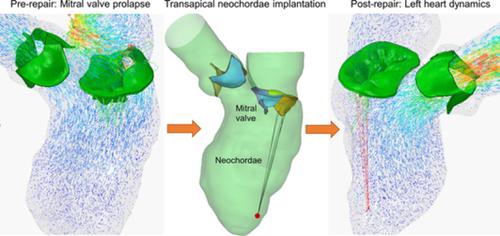当前位置:
X-MOL 学术
›
Int. J. Numer. Method. Biomed. Eng.
›
论文详情
Our official English website, www.x-mol.net, welcomes your
feedback! (Note: you will need to create a separate account there.)
Transapical mitral valve repair with neochordae implantation: FSI analysis of neochordae number and complexity of leaflet prolapse.
International Journal for Numerical Methods in Biomedical Engineering ( IF 2.2 ) Pub Date : 2019-12-20 , DOI: 10.1002/cnm.3297 Andrés Caballero 1 , Wenbin Mao 1 , Raymond McKay 2 , Wei Sun 1
International Journal for Numerical Methods in Biomedical Engineering ( IF 2.2 ) Pub Date : 2019-12-20 , DOI: 10.1002/cnm.3297 Andrés Caballero 1 , Wenbin Mao 1 , Raymond McKay 2 , Wei Sun 1
Affiliation

|
Transapical mitral valve repair with neochordae implantation is a relatively new minimally invasive technique to treat primary mitral regurgitation. Quantifying the complex biomechanical interaction and interdependence between the left heart structures and the neochordae during this procedure is technically challenging. The aim of this parametric computational study is to investigate the immediate effects of neochordae number and complexity of leaflet prolapse on restoring physiologic left heart dynamics after optimal transapical neochordae repair procedures. Neochordae implantation using three and four sutures was modeled under three clinically relevant prolapse conditions: isolated P2, multi‐scallop P2/P3, and multi‐scallop P2/P1. A fluid‐structure interaction (FSI) modeling framework was used to evaluate the left heart dynamics under baseline, prerepair, and postrepair states. Despite immediate restoration of leaflet coaptation and no residual mitral regurgitation in all postrepair models, the average and peak stresses in the repaired scallop(s) increased >40% and >100%, respectively, compared with the baseline state. Additionally, anterior mitral leaflet marginal chordae tension increased >30%, while posterior mitral leaflet chordae tension decreased at least 30%. No marked differences in hemodynamic performance, in native and neochordae forces, and in leaflet stress were found when implanting three or four sutures. We report, to our knowledge, the first set of time‐dependent in silico FSI human neochordae tension measurements during transapical neochordae repair. This work represents a further step towards an improved understanding of the biomechanical outcomes of minimally invasive mitral valve repair procedures.
中文翻译:

经新索达植入的经心尖二尖瓣修复:新索达数量和小叶脱垂复杂性的FSI分析。
经新腱索植入的经心尖二尖瓣修复是一种相对较新的微创技术,可用于治疗原发性二尖瓣关闭不全。在此过程中,量化左心脏结构与新腱索之间复杂的生物力学相互作用和相互依赖性在技术上具有挑战性。这项参数化计算研究的目的是研究最佳经心尖根破线修复程序后,新线叶数目和小叶脱垂的复杂性对恢复生理性左心动态的即时影响。在三种临床相关的脱垂情况下对使用三线和四线缝合的线虫进行建模:分离的P2,多扇贝P2 / P3和多扇贝P2 / P1。流体结构相互作用(FSI)建模框架用于评估基线以下的左心动力,修复前和修复后的状态。尽管在所有修复后的模型中小叶接合迅速恢复并且没有残留的二尖瓣反流,但是与基线状态相比,修复后的扇贝的平均应力和峰值应力分别增加了40%和100%以上。此外,二尖瓣前叶边缘腱索张力增加> 30%,而二尖瓣后叶腱索张力至少降低30%。植入三或四根缝合线时,在血流动力学性能,自然和新腱索力以及小叶应力方面均未发现明显差异。据我们所知,我们报告了经心尖根新脊索修复过程中第一组时间依赖性的计算机模拟FSI人类新脊索张力测量。
更新日期:2019-12-20
中文翻译:

经新索达植入的经心尖二尖瓣修复:新索达数量和小叶脱垂复杂性的FSI分析。
经新腱索植入的经心尖二尖瓣修复是一种相对较新的微创技术,可用于治疗原发性二尖瓣关闭不全。在此过程中,量化左心脏结构与新腱索之间复杂的生物力学相互作用和相互依赖性在技术上具有挑战性。这项参数化计算研究的目的是研究最佳经心尖根破线修复程序后,新线叶数目和小叶脱垂的复杂性对恢复生理性左心动态的即时影响。在三种临床相关的脱垂情况下对使用三线和四线缝合的线虫进行建模:分离的P2,多扇贝P2 / P3和多扇贝P2 / P1。流体结构相互作用(FSI)建模框架用于评估基线以下的左心动力,修复前和修复后的状态。尽管在所有修复后的模型中小叶接合迅速恢复并且没有残留的二尖瓣反流,但是与基线状态相比,修复后的扇贝的平均应力和峰值应力分别增加了40%和100%以上。此外,二尖瓣前叶边缘腱索张力增加> 30%,而二尖瓣后叶腱索张力至少降低30%。植入三或四根缝合线时,在血流动力学性能,自然和新腱索力以及小叶应力方面均未发现明显差异。据我们所知,我们报告了经心尖根新脊索修复过程中第一组时间依赖性的计算机模拟FSI人类新脊索张力测量。











































 京公网安备 11010802027423号
京公网安备 11010802027423号